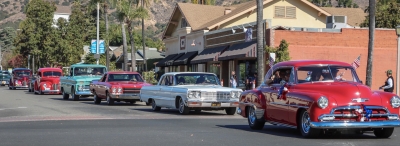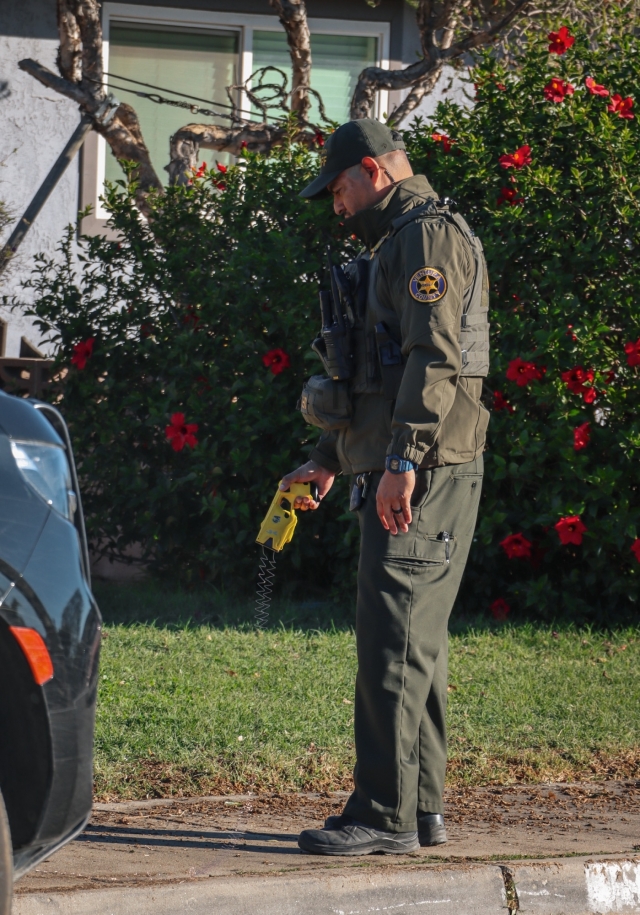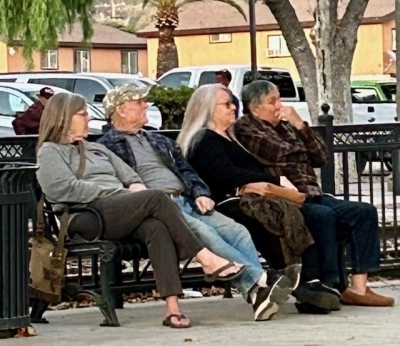|
By Gazette Staff Writers — Thursday, November 14th, 2024
 On Thursday, November 7, about 8:00 a.m., two Fillmore patrol deputies were on a subject stop on C Street and Ortega Street. According to the Ventura County Sheriff’s Office the subject was displaying symptomology of being under the influence of a controlled substance. The subject walked away from deputies after being told he was being detained. The subject displayed pre-assaultive behavior and was tased, then taken into custody. When deputies searched the subject, a white crystal-like substance and a syringe with a capped needle were located in his pants pocket. The subject was arrested for violation of PC 148(a)(1)- Resisting or obstructing a peace officer, HS 11550(a)- Under the influence of a controlled substance, HS 11364(a)- Possession of drug paraphernalia and HS 11377(a)- Possession of a controlled substance. Photo credit Angel Esquivel. Enlarge Photo |
|
By Gazette Staff Writers — Thursday, November 14th, 2024
 On Monday, November 11, 2024, Fillmore hosted its annual Veterans Day Parade at 10am on Central Avenue. Classic cars cruised downtown Fillmore as folks waved and thanked our local Veterans for their service and sacrifice, a longtime Fillmore tradition. On Saturday, November 9th, folks gathered in front of Fillmore City Hall for the Veterans Day Celebration in the Park, also put on by the Veterans Day Celebration Committee. From 4pm to 7pm, the community came out to listen to music, enjoy food and dance the night away. Photo credit Angel Esquivel. Enlarge Photo  Pictured is Fillmore VFW Post 9637 proudly displaying every military branch flag along with the carrying of the American flag to get the Veterans Day parade started. Above and below photo credit Angel Esquivel. Enlarge Photo  The band “Heart & Soul” grooving away as folks dance Friday night at the Concert in the Park. Photo credit Fillmore Veterans Day Celebration Committee. Enlarge Photo  Fillmore High School Marching Band showed off their skills at the Veterans Day Parade on Monday. Photo credit Gazette Staff. Enlarge Photo The Veterans Day weekend kicked off to a great start with its Concert in the Park last Saturday, November 9, 2024, from 4pm to 7pm. Everyone had a great time with about 80 attending the concert featuring “Heart and Soul” at City Hall. Many were Fillmore and Piru Vets enjoying the music. The City of Fillmore proclaimed the month of November as “Veterans and Active Military Month” honoring those who served and are serving our country. |
Now Hiring: Deputy City Clerk
The City of Fillmore is seeking a detail-oriented and highly organized professional to join our City Clerk’s Office as Deputy City Clerk. This key role supports City Council operations, maintains official records, ensures legal compliance, and helps uphold transparency in local government. If you’re passionate about public service, governance, and supporting elected officials, we encourage you to apply. Learn more and apply at www.fillmoreca.gov.
 A fixed-wing plane drops red flame retardant on the Mountain Fire. Photo credit Angel Esquivel. Enlarge Photo By Gazette Staff Writers — Thursday, November 14th, 2024
On Wednesday, Nov-ember 6th, at 8:51 a.m., the Ventura County Fire Department was dispatched to a brush fire reported near 7930 Balcom Canyon Road and Bradley Road. The fire was located, quickly growing to hundreds of acres in size during Santa Ana conditions. The Public Information Officer for VC Fire was reporting as of 9:23am that 148 firefighters and 58 units had already arrived. * Unincorporated Somis * West to: Saticoy Country Club * East to Balcom Canyon Road * South to Highway 118 Firefighters were conducting structure protection for numerous residences with reports of fast approaching fire. As of 11:17am, VC Fire was reporting that the fire was expected to impact the entire area of Camarillo Heights. Law enforcement was being requested in the area of West Loop for traffic control. Anyone calling from this area is being told to evacuate and that the priority is life safety and not property. *** 5:50pm, multiple houses have burned, including in the area of Valley Vista Drive in Camarillo. The fire was estimated at over 10,000 acres with no containment. Ventura County authorities held a press conference with additional information, found at the following YouTube link: https://www.youtube.com/live/5QIUgGrdh8c *** According to www.vcemergency.com , the following evacuation orders had been issued as of 9:18am on November 6 of 2024, for a brush fire call starting in the area of 7930 Balcom Canyon Road near Bradley Road: Zone 1 – North of Somis: areas north of East Los Angeles Avenue/Hwy 118, west of Balcom Canyon Road, and east of La Vista Avenue Zone 2 – Saticoy Country Club: east of Los Angeles Ave/Hwy 118, and south of the Santa Clara River and north of Beardsley Road Zone 3 – Areas south of Hwy 118, west of N. Lewis Road, north of North Loop Drive and Mission Drive, and east of Fairway Drive Zone 4 – West Camarillo (Las Posas/Spanish Hills areas): north of Las Posas Road, south and east of Central Avenue and Beardsley Road, and west of Anacapa Drive Zone 6 – The area extending south of Santa Clara River, east of Los Angeles Avenue, north of Saticoy County Club, and west of Briggs Road Zone 7 – The area north of Hwy 101 and south and east of Beardsley Avenue, and south of Central Avenue Zone 9- The area east of Santa Paula Community Golf Course, north along Santa Clara River, west of San Cayetano Street Zone 10 – The area south of the Santa Clara River, north of the ridge bottom of South Mountain at the rock quarry, west of Grimes Canyon Road, east of San Cayetano Street Fire conditions are heavy and fast moving, and have consumed residences. Firefighters and emergency resources responding to help you during imminent conditions will be at risk. *** By 5:50pm, the fire was estimated at over 10K acres burned with 0% containment. Originally beginning near the 7900 block of Balcom Canyon Road near Bradley Road near Somis and Moorpark, the fire moved quickly towards the Camarillo Heights area. Several homes were consumed by the flames, including along Valley Vista Drive. The fire continued towards the area of the 101 Freeway and Central Avenue with smoke heavily impacting the area. *** Air resources had been limited due to the strong winds. Due to the size and severity of the fire, the primary mission of the firefighters was to save lives over structure protection. Multiple calls of people being trapped at their property had come into dispatch. Multiple ambulance transports had occurred in the morning with some people becoming injured. Traffic jams in the evacuation zones were quickly responded to with additional law enforcement aiding in clearing the people out of the fire’s path. The fire fight was continuing through the evening, night, and for the foreseeable future until it can be contained and handled. *** Sheriff James Fryhoff has issued a Local Emergency Proclamation and has requested California Governor Gavin Newsom proclaim a State of Emergency for the areas impacted, according to the website. These emergency proclamations are vital steps to activating state and federal assistance programs for both fire suppression efforts and assisting residents, the website said. The fire was actively hitting the Santa Paula area with evacuation orders found at the County website. *** Numerous evacuation orders, listed on www.vcemergency.com , were still in effect Friday evening. Firefighters were working perimeters in Somis, Camarillo Heights and Santa Paula. |
|
By Gazette Staff Writers — Thursday, November 14th, 2024
 The Mountain Fire has burned nearly 21,000 acres by Tuesday morning, destroying approximately 130 structures, and 88 structures have been damaged. Starting in the Balcom Canyon area and progressing heavily west to the north and south, the Santa Ana winds remain a concern. Photos taken near Santa Paula. Photo credit Angel Esquivel. Enlarge Photo |
|
By Gazette Staff Writers — Thursday, November 14th, 2024
 Due to winter storms that damaged the sub-structure of the Sespe bike path, “warning” signs have been posted at the entry gates . The city is currently in the design phase of the repairs. Construction should begin in late spring and the area should be re-opened for summer use. Photo credit Gazette staff. Enlarge Photo |
|
By Gazette Staff Writers — Thursday, November 7th, 2024
Palacio, Gradias Win FUSD Trustee Seats
Ventura County Voter Turnout (51.69%) |
|
By Gazette Staff Writers — Thursday, November 7th, 2024
On Friday, November 1st, at 2:30 a.m., Ventura County Fire Department, AMR Paramedics, and California Highway Patrol were dispatched to a cell phone crash notification on Highway 126 near Camino Del Rio, just east of Piru, near the Los Angeles County line. Arriving firefighters reported a solo vehicle overturned with one person trapped and unresponsive. Per CHP, the driver, who was alone in the 2019 Jeep Wrangler, was pronounced dead at the scene. In an update Friday afternoon, CHP officials said a 29—year-old Fillmore woman was driving the Jeep and had travel onto the right shoulder, which was covered with dirt and brush. It wasn’t immediately known how fast the vehicle was going or why it went off the roadway. The Jeep continued on the shoulder until it struck a drainage culvert, authorities said in a news release. The Jeep flipped over onto its roof and came to rest on the right shoulder west of the culvert. The vehicle sustained major damage. The driver’s name wasn’t released pending notification of family. Investigators don’t yet know whether drugs or alcohol were a factor, according to the release. The accident remains under investigation. Anyone with information about Friday’s collision is asked to call the CHP Moorpark-area office at (805)553-0800. |
|
By Gazette Staff Writers — Thursday, November 7th, 2024
 Don’t miss Fillmore’s Veterans Day Celebration and Parade. The Veterans Day Celebration Concert in the park is Saturday, November 9, from 4pm to 7pm in front of Fillmore’s City Hall. Don’t forget your chairs! Fillmore’s Veteran’s Day Parade will be Monday, November 11, at 10am on Central Avenue, from 2nd Street to Santa Clara Street. Presented by Veterans Day Celebration Committee and sponsors. See page 2 for more details. Enlarge Photo |
 Pictured are local Piru rangers giving a talk to the volunteers about the local history and wildlife. Inset, volunteers counting tamarisk for data collection. Photos courtesy John Ziegler, Marketing Manager, Channel Islands Restoration. Enlarge Photo By Gazette Staff Writers — Thursday, November 7th, 2024
Channel Islands Restoration (CIR) hosted a family-friendly volunteer day at Lake Piru to clear Tamarisk and other invasive weeds in Piru Creek on October 26th. Tamarisk can consume up to 200 gallons daily, threatening local biodiversity and harming wildlife. Removing these weeds can help restore the forest’s natural beauty and ecological health. Agenda for the day was Volunteer Work: Teamed up with fellow environmental advocates to remove tamarisk and other invasive weeds; Educational Talks: Heard from experts about the native ecology of the Piru Creek Watershed; Food and Refreshments: Enjoyed lunch and snacks thanks to CIR. It was a chance to make a tangible difference in preserving the local environment, and to protect and nurture a riparian zone. Volunteers brought their enthusiasm and commitment! |
|
By Gazette Staff Writers — Thursday, November 7th, 2024
 It looks like the City Hall Plaza Restoration is continuing with the fountain drained and cleaned. Sidewalks have already been replaced. Mountain View Street Sidewalk Extension is also on the city agenda, with bid requests posed in the Fillmore Gazette on August 8, 2024. The engineer’s estimate for the combined project was $643,708. Complete breakdown of cost/project can be viewed at www.FillmoreGazette.com under Front Page. Photo credit Gazette Staff. PDF Link: file://gazettenas/CurrentEdition/11-07-2024-EDITION/City%20Hall%20Area%20Facelift%20Continues/City-Hall-Area-Facelift-Continues-11-7-2024-SR_-_SIDEWALKS_AND_PLAZA_AWARD_OF_CONTRACT_FOR_PROJECT_SPEC_NO._24-02.pdf Enlarge Photo |












